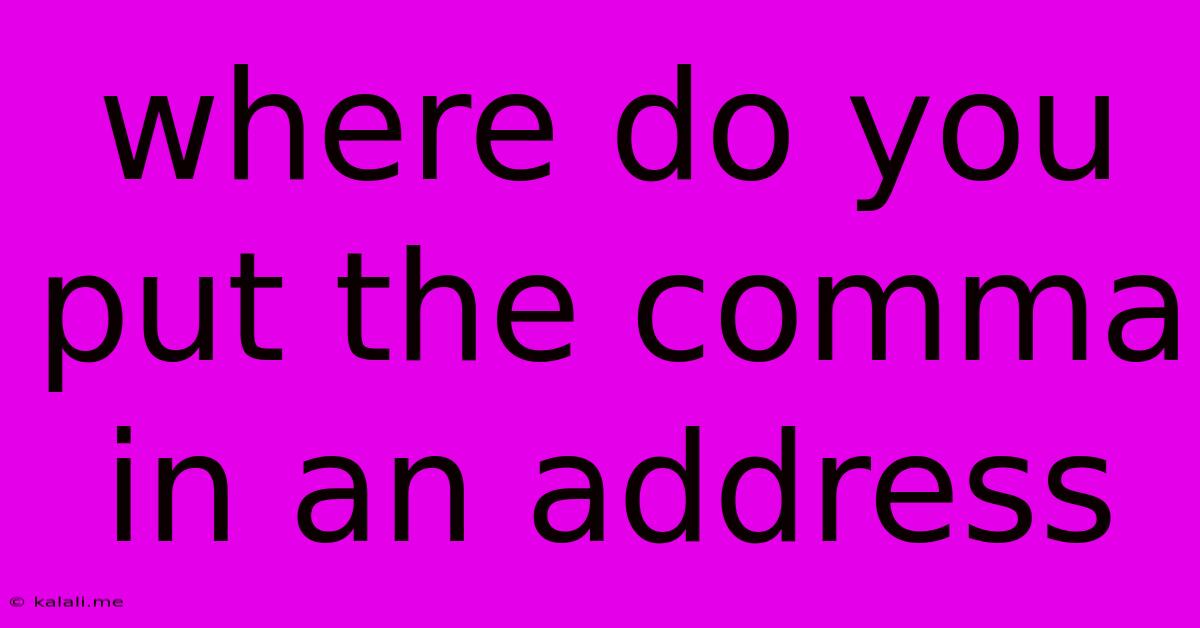Where Do You Put The Comma In An Address
Kalali
Jun 05, 2025 · 3 min read

Table of Contents
Where Do You Put the Commas in an Address? A Comprehensive Guide
Knowing where to place commas in an address is crucial for clear communication and proper formatting, especially in formal settings like business letters or legal documents. Incorrect comma placement can lead to confusion and even errors in delivery. This guide provides a comprehensive breakdown of comma usage in addresses, covering various address formats and styles.
Understanding the Importance of Correct Comma Placement in Addresses
Correct comma usage in addresses is essential for several reasons. Primarily, it ensures clarity and readability, making it easier for recipients and mail carriers to understand the location. Incorrect punctuation can lead to delays, misdeliveries, and potentially lost mail. Additionally, proper formatting demonstrates attention to detail and professionalism, particularly in formal correspondence.
The Standard Comma Rules for Addresses
The basic rule for comma placement in addresses adheres to a consistent pattern, irrespective of the country or region. Remember that these rules primarily apply to addresses written in a single line or stacked vertically.
-
Street Number and Street Name: A comma separates the street number and the street name. For example: 123 Main Street,
-
Street Name and City: A comma follows the street name and precedes the city. For example: 123 Main Street, Anytown,
-
City and State: A comma separates the city and the state. For example: 123 Main Street, Anytown, CA,
-
State and Zip Code: No comma is needed between the state and zip code. Example: 123 Main Street, Anytown, CA 90210
Addressing Different Address Formats:
While the standard rules generally apply, the format can change depending on how you present the address.
1. Single-Line Address: This format is commonly used in email signatures or informal correspondence. Commas are placed as described above. Example: 123 Main Street, Anytown, CA 90210
2. Multi-Line Address: This is the preferred format for formal letters and mailing envelopes. Each line typically contains a single element of the address, and commas are used only between the city and the state. Example:
123 Main Street
Anytown, CA 90210
3. International Addresses: International addresses often require additional elements and a slightly different comma structure. The general principle remains: separate elements with commas for clarity. You may need to include the country name after the zip or postal code. Always check the specific postal guidelines for the target country. Example:
123 Main Street
Anytown, CA 90210
USA
4. Addresses with Apartment Numbers or Suite Numbers: These are placed after the street address and before the city. Use commas to separate them clearly.
Example: 123 Main Street, Apt 4B, Anytown, CA 90210
Common Mistakes to Avoid:
- Extra Commas: Avoid using unnecessary commas. The most common mistake is placing a comma between the state and zip code.
- Missing Commas: Failure to include essential commas can create ambiguity and confuse postal services.
- Inconsistent Formatting: Maintain a consistent formatting style throughout your address.
Conclusion:
Mastering the correct use of commas in addresses is a vital skill for effective communication and ensuring mail delivery. By understanding the standard rules and adapting them to different address formats, you can ensure your correspondence is clear, professional, and efficiently processed. Remember to double-check your address for accuracy before sending it. Correct punctuation is a small detail that can make a big difference.
Latest Posts
Latest Posts
-
Blender Video Editor Extended A Sound
Jun 06, 2025
-
Why Did Kiki Lose Her Powers
Jun 06, 2025
-
Dystopian Novels When The Side N
Jun 06, 2025
-
How Do I Restart Pokemon Alpha Sapphire
Jun 06, 2025
-
How To Use Too In A Sentence
Jun 06, 2025
Related Post
Thank you for visiting our website which covers about Where Do You Put The Comma In An Address . We hope the information provided has been useful to you. Feel free to contact us if you have any questions or need further assistance. See you next time and don't miss to bookmark.